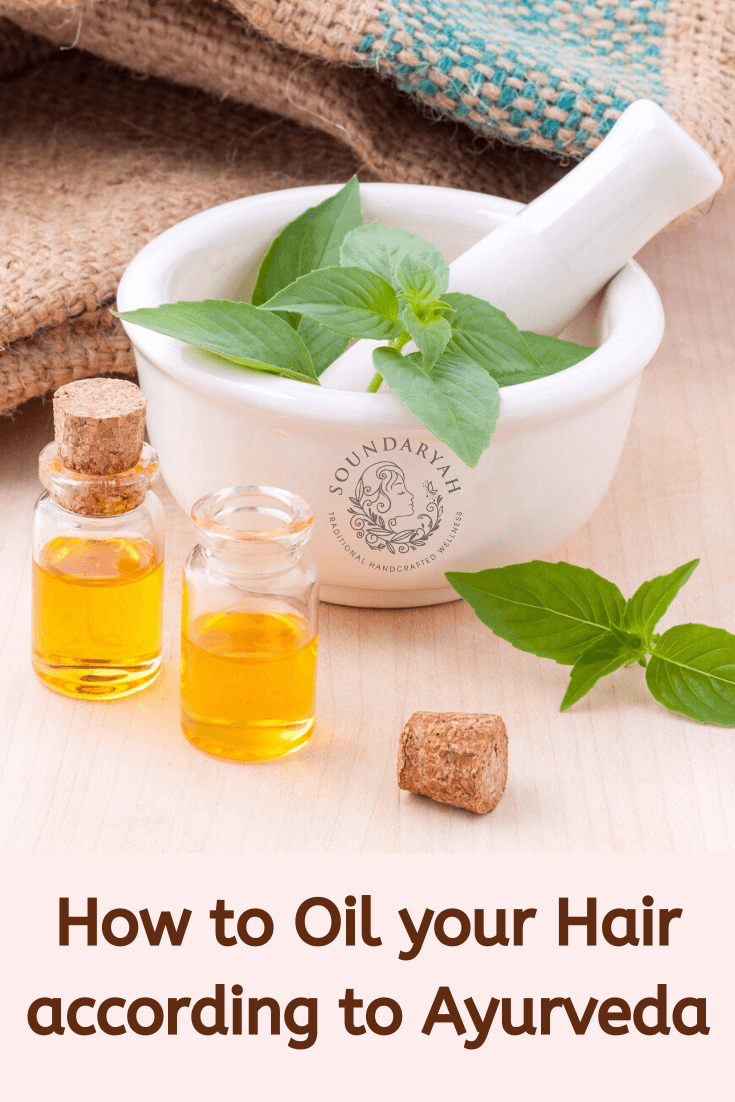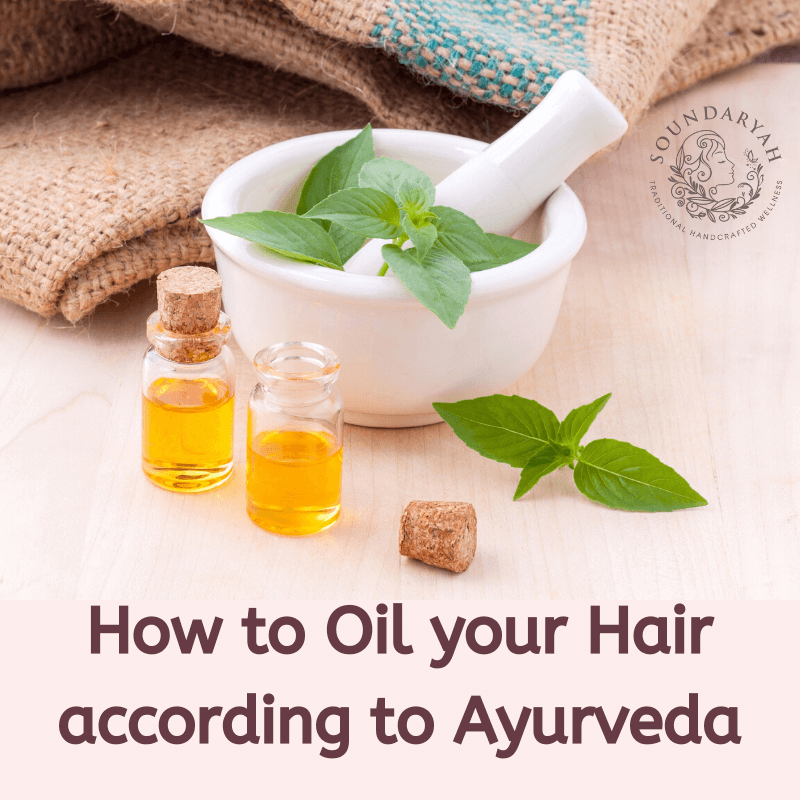Oiling can be one of the most beneficial things for overall health! Here is a guide on how to oil your hair according to Ayurvedic principles.
Oiling our hair is not something new to Indians, although the western world may have just discovered its benefits. For generations now, we have been having our hair oiled by our mothers and grandmothers – sometimes to the point where we run away when we see them approaching with a bottle of oil!
Now that we’re older and wiser, we know that oiling the hair has many benefits, most of them rooted in Ayurveda. Ayurveda refers to oiling the hair and scalp as Murdha Taila, claims that it helps to balance the pitta dosha in the body.
The pitta dosha helps us process the information we take in every day through our sense organs, and applying oil to the head is believed to make us sharper and healthier. Besides this, oiling also has other benefits:
- Moisturizes dry hair
- Makes hair stronger and shinier
- Promotes hair growth
- Treats and prevents premature greying
- Treats dandruff and other scalp conditions
- Promotes relaxation
Women of previous generations took a lot of time and effort into caring for their hair, something we struggle with given our hectic modern schedules. What’s more, we also subject our hair to atmospheric pollutants, heat styling and products loaded with chemicals. Needless to say, our hair is crying out for some traditional TLC!
The easiest way to give your hair this loving care is by oiling. However, oiling the hair and scalp needs to be done the right way and with the right kind of oil. You can use a mixture of carrier oil and essential oil, or go with the carrier oil alone. Once you’ve chosen your oil, it’s time to decide how you want to oil your hair. Here are the different ways to oil your hair as outlined by Ayurveda.
How to Oil your Hair according to Ayurveda

-
Pre-shampoo Treatment

This is probably the most familiar kind of oil application for most of us. Here, a carrier oil or a mixture of oils and herbs is applied all over dry scalp and hair, and left on for some time, before being washed off. This allows the oil some time to get absorbed by the hair, so the moisture stays locked in even after the wash.
The benefit of this application is that you can adjust it based on how much time you have. It is recommended to leave the oil on for at least 15 minutes to an hour. You can use nearly any kind of oil or combination of oils in this treatment.
If you have an oily scalp, you can do this treatment twice a week, and more if your hair is extremely dry. In any case, it is not recommended to oil the scalp every day, as it can backfire and affect the body’s own oil-producing process. It can also leave you with flat, greasy looking hair and may trigger acne in some skin types.
Also Read: Honey and Cinnamon – The Secret Potion of Health and Beauty
-
Hot Oil Treatment

A hot oil treatment is a term that is tossed around a lot by beauty parlours, but very few of them follow it according to Ayurvedic principles. Although the word used is ‘hot’, the oil is actually comfortably warm. The heat is believed to open up the pores and cuticles and absorb the oil completely, taking in all its nutrients.
To do the hot oil treatment, you can choose any oil, although sesame oil is the most popular pick. Place a bowl of oil in a bigger bowl of hot water till it is as warm as you want it. Be careful not to overheat the oil – besides the danger of burning, overheating kills the nutrients in the oil.
Once you’ve oiled the scalp and hair sufficiently, you can wrap your head in a hot, damp towel and leave it on for some time to really absorb the goodness of the oil. If you’re pressed for time, you can apply oil at room temperature and wrap with the hot towel.
The hot oil treatment is not recommended for people with frequent headaches or a pitta imbalance.
-
Overnight Treatment

For some really intense TLC, go with an overnight treatment once in a while. Here, the oil is applied in the evening and washed off in the morning. This gives the oil enough time to get absorbed in completely, and the evening massage also helps promote sleep.
However, overnight treatment needs to be done with a lot of care. After applying the oil, tie up your hair and cover your hair and pillows to prevent an oily mess. Also, it is advised to use a lighter oil and apply only a small quantity on the scalp, focusing more on the massaging. You may want to avoid this if you tend to catch colds easily.
-
Steaming

Have you seen pictures of ancient Indian queens and princesses sitting amidst flowers and herbs while a lady holds her hair over a steaming substance? Well, it turns out that’s one reason they had such lovely hair back then!
The steam opens up the cuticles and helps the oil penetrate into the hair. You can also get tresses worthy of a royal by steaming your hair. Steaming is done in many parlours these days, with specialized equipment for the purpose. Steaming at home by yourself will require a bit of effort, but saves you a trip to the parlour and is lighter on your pocket. All you need is a face towel and two shower caps.
Apply oil along the length of your hair, paying special attention to the dry parts. Tie up your hair in a low bun and cover it with a shower cap. Put on a pair of heat resistant gloves. Dip a face towel in hot water and wring it out. Place the hot towel on top of your shower cap, and cover it with another shower cap so the steam stays trapped in. Leave it on for 30 minutes and then rinse hair with cold water.
-
Scalp massage

According to Ayurveda, there are certain energy points on the head and body, called ‘marma’. Much like acupuncture pressure points in Chinese medicine, massaging the marma has special benefits. You may have noticed this whenever you got a good head massage or abhyanga, as it is called in Ayurveda.
Massaging the marma on the scalp has relaxing benefits as well as promoting healthy hair. While getting it done by someone else is more effective, you can do the massage on your own. However, it is important to apply the right amount of pressure – too much can create knots and damage the hair roots.
-
Leave-in Treatment

While not exactly an Ayurvedic treatment, this is based on the idea of hair oil being a cure for all your hair problems, including everyday frizz. All you need to do is pour your favourite oil into a small spray bottle and spray over your hair strands whenever they’re looking too dry or feeling too rough. Comb through the hair to evenly distribute the oil and leave it in.
Oil spraying helps give a thin film of oil without coating the hair and making it greasy. One thing to remember here is to use a lightweight oil and to avoid spraying the roots. Some people find that spraying this over freshly washed hair helps in keeping frizz at bay all day.
Step by Step Guide to Oiling your Hair Correctly
- Pour a teaspoon of oil into a small bowl. Always start with a small quantity – you often need less than you think.
- Dip a ball of cotton into the oil, squeeze to remove any excess and rub it gently along the scalp.
- Use the pads of your fingertips (not nails) to massage the oil in gently, using circular motions. Remember the backs of the ears and back of the head.
- Divide hair into two parts and place each part in front of either shoulder. Start with one section at a time.
- Apply some oil to your palm, and apply along the length of the hair, paying special attention to the dry ends.
- Repeat on the other section. If your hair is very thick, divide it into four sections.
- Hair is fragile right after oiling, so tie it up gently in a loose knot till it’s time to wash.
Taking the time to oil your hair can be one of the most relaxing parts of your day. It nourishes your hair, relaxes you and also makes your senses sharper and more alert. Avoid oiling when you have a fever or cold. Also, take the time to identify your hair type and choose an oil that suits it – a little effort invested now will pay off in the long run!

Did you find our How to Oil Your Hair according to Ayurveda blog interesting, please let us know in the comments section.
For more interesting updates do follow us on Facebook and Instagram.


 Verified Purchase
Verified Purchase



![Youthful Glow Herbal Face Wash [100g] - Soundaryah](http://soundaryah.com/cdn/shop/products/1a_b5d64eda-7417-41b9-bad5-b271f4ef68ff_300x.jpg?v=1634899930)
![Royal Herbal Hair Wash [200g] - Soundaryah](http://soundaryah.com/cdn/shop/products/1_300x.jpg?v=1669120964)
![Intensive Body Polishing Ubtan [200g] - Soundaryah](http://soundaryah.com/cdn/shop/products/1a_8728dcb7-c696-447d-b42e-0a56a5326fb6_300x.jpg?v=1634899848)